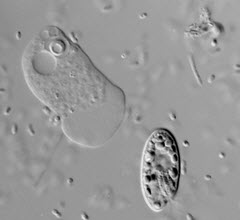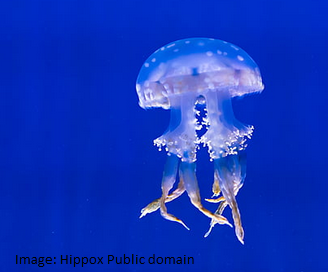Osmoregulation
 Students learn about three methods of controlling water balance in this lesson. A short presentation reminds students about osmosis and introduces some examples osmoconformers and osmoregulators from the natural world. A second activity outlines the different ways osmoregulators control their water balance and a worksheet of questions support the presentations. A final activity is more analytical and looks at the methods of nitrogenous waste excretion which have evolved in line with the different osmoregulatory systems.
Students learn about three methods of controlling water balance in this lesson. A short presentation reminds students about osmosis and introduces some examples osmoconformers and osmoregulators from the natural world. A second activity outlines the different ways osmoregulators control their water balance and a worksheet of questions support the presentations. A final activity is more analytical and looks at the methods of nitrogenous waste excretion which have evolved in line with the different osmoregulatory systems.
Lesson Description
Guiding Questions
- How do marine invertebrates avoid osmosis?
- If osmoconformers control salts what do osmoregulators control?
Activity 1 - Diffusion Osmosis and osmoregulation
Remember osmosis - read the following slides about ![]() Osmosis and osmoregulation
Osmosis and osmoregulation
Using the ![]() Jellyfish - osmoconformers student worksheet annotate the simple jellyfish diagram - to illustrate this example of osmoconforming marine invertebrates
Jellyfish - osmoconformers student worksheet annotate the simple jellyfish diagram - to illustrate this example of osmoconforming marine invertebrates
Explain how this animal avoids the problems of osmosis using the following labels
Salt water environment contains salts
- Cytoplasm contains dissolved salts
- Salt is taken into body cells (by active transport)
- Solute concentrations are equal
- No net movement of water by osmosis
There is a rather nice introduction to jellyfish (or sea jellies) from Nat. Geographic - ![]() Jellyfish 101
Jellyfish 101
Activity 2 - Osmoregulation in single cells
Watch the short video ![]() Paramecium contractile vaculole
Paramecium contractile vaculole
Using the ![]() osmoregulation - paramecium student worksheet annotate the diagram illustrating how this single celled Paramecium, which lives in fresh water, copes with constant inward osmosis from the surrounding water into its cytoplasm.
osmoregulation - paramecium student worksheet annotate the diagram illustrating how this single celled Paramecium, which lives in fresh water, copes with constant inward osmosis from the surrounding water into its cytoplasm.
Include the following labels:
- Plasma membrane
- Cytoplasm
- Contractile vacuole
- Fresh water environment
- Higher solute concentration
- Lower solute concentration
- Osmosis (water moves in this direction)
- Exocytosis (water moves in this direction)
Then answer the questions about osmoregulation in other animals
Activity 3 - Excretion of nitrogenous waste and how it links to osmoregulation
Look first at the ![]() nitrogenous excretion slides which introduces the different methods animals use to excrete nitrogenous waste.
nitrogenous excretion slides which introduces the different methods animals use to excrete nitrogenous waste.
Answer the IB style questions on ![]() the osmoregulation and excretion worksheet
the osmoregulation and excretion worksheet
.
Teacher's notes
In the IB guide it is not entirely clear how much detail is required for this section. The resources on this page have been kept as simple as possible while still explaining the concepts of osmoregulation and excretion. It is assumed that students will not have studied the kidney nephron in any detail at this point.
The three activities are short and all quite similar; with a short presentation followed by a short worksheet of questions or activities. I would use the slides to introduce the concepts with the whole class and then ask students to answer the questions which follow. It is also possible to ask students to look at the slides and work through this lesson independently.
Model answers will be found using the links on the left.

 IB Docs (2) Team
IB Docs (2) Team
